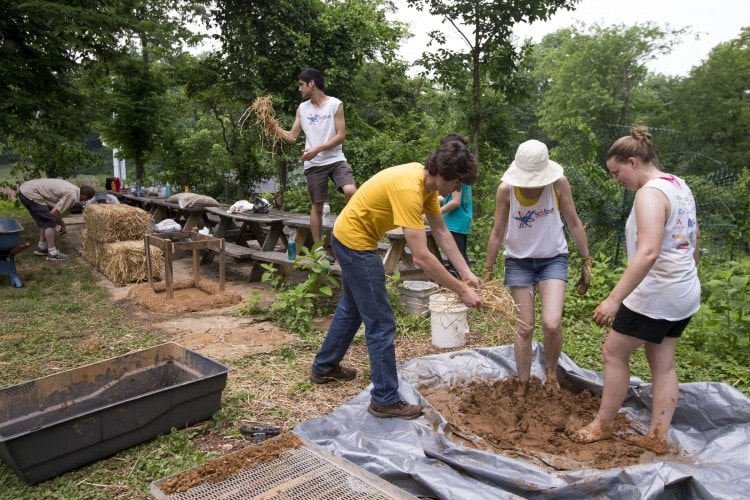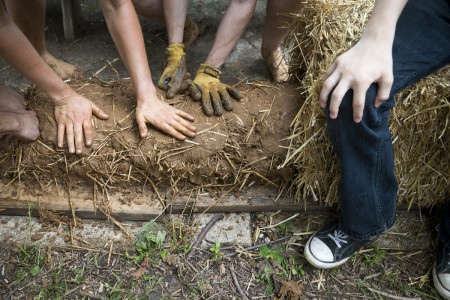Student research shows tiny houses can lead to big savings

Environmental Studies Professor Karin Warren and Sara Woodward ’16 mix up a batch of cob as Sustainability Coordinator Ludo Lemaitre (center) adds more straw at a site where a tiny house could be built.
After hearing a lecture on the benefits of micro housing during the fall 2014 semester, Sara Woodward ’16 joked with Karin Warren, the Herzog Family Chair of Environmental Studies, about building a “hobbit house” on the Randolph College campus.
The idea became a serious one in the spring 2015 semester, when Woodward took Warren’s Energy and Society class. For a semester project, she and her classmates studied the components of a tiny house, such as energy supply, sewage and waste disposal, and rainwater harvesting. They presented their findings at the Symposium of Artists & Scholars.
Inspired by what they learned, Woodward and classmate Hagay Haut ’16 continued their work as a Summer Research project. The two environmental studies majors have teamed up with Warren, as well as Randolph Sustainability Coordinator Ludovic Lemaitre ’11, to create a comprehensive design for a tiny house.
The tiny house movement started in 1997, when architect Sarah Susanka published The Not So Big House. In her book, Susanka explains how micro housing promotes sustainable, downsized, and simple living. In addition to embracing a minimalist lifestyle, tiny houses are also environmentally friendly, since most of them are designed to generate electricity from solar, wind, and other renewable energies.
Tiny houses come in many shapes and sizes, and they can be built from the ground up or be hitched onto trailers and used as mobile homes. The Randolph students’ design uses natural building materials like cob, a hardened mixture of clay and straw, in place of traditional brick and cement.
“Technically a tiny house is anything under 1,000 square feet, but a lot of them go down under 200 square feet, sometimes smaller than a dorm room,” said Haut. “What we’re aiming for in our demonstration is something around 180 square feet, and probably a one-room dwelling that has all the living components like a place to sleep and a kitchen.”
Warren said their plans consider economic, environmental, and social impacts, otherwise known as the three pillars of sustainability. Both Woodward and Haut said they wouldn’t mind living in a tiny house.
“I would be very open to it, mostly because of the economic consideration,” said Haut.
He estimated that while the average house can cost at least $100,000 to build, the students’ design would require a tiny budget in comparison, since it would be built using cob, borrowed tools, and repurposed waste materials.
“We’re looking at a couple thousand dollars,” said Haut. “I think the economic argument for tiny house building is one of the strongest I’ve seen.”
In addition to Warren’s contributions and mentoring role, Haut and Woodward are receiving help from several sources outside the College. Lemaitre is one of several alumni supporting the project, who, along with his role as sustainability coordinator, recently became a licensed real estate agent.
Another alumnus, Adam Eller ’13, is an environmental specialist for the Virginia Department of Environmental Quality, and has helped the group. The students have also received feedback from Megan Bloomer ’06, who is sustainability coordinator for The Cheesecake Factory.
Spencer Cohen, a local high school student with an interest in architecture, is also helping the group.
Warren believes tiny houses could be one solution to address homelessness. For instance, Boneyard Studios, a previously abandoned alleyway in Washington, D.C., has been repurposed into a tiny house community. She would like to see a tiny house built on Randolph’s campus one day.
“I don’t think every Randolph student needs to live in their own tiny house, but it would be nice to have a little village so it’s another option, especially for people who are very interested in eco conscious living and trying to promote sustainability on campus,” she said.
Tags: environmental studies, Hagay Haut, Karin Warren, Ludovic Lemaitre, Sara Woodward, summer research, Summer research 2015, sustainability, sustainability research, sustainable living

